All products featured are independently chosen by us. However, SoundGuys may receive a commission on orders placed through its retail links. See our ethics statement.
Apple AirPods Max vs AirPods Pro (2nd generation)



Now that the Apple AirPods Pro (2nd generation) has been released, you might be thinking about getting a pair. On the other hand, you’ve probably seen the Apple AirPods Max everywhere and know that it’s about as premium as wireless headphones get. If you’re an iPhone user in search of an Apple-specific audio option and can’t choose between the two, we’ve got you covered. We put the Apple headsets up against each other to see which wireless option is best for your needs. Find out in this Apple AirPods Max vs AirPods Pro 2 showdown!
Editors note: This article was updated on June 11, 2024, to adjust formatting and answer more FAQs.
What’s it like to use the Apple AirPods Pro 2 compared to the AirPods Max?
The Apple AirPods Pro (2nd generation) is very similar to the previous generation, still featuring glossy white stemmed earbuds with a rounded rectangular case. The case has a speaker in it, so you can locate it if it gets lost using Find My AirPods. The new USB-C version of the AirPods Pro is IP54-rated, so they can handle dust and splashes of water without sustaining damage. The AirPods Pro (2nd generation) comes with four ear tip sizes, including the usual small, medium, and large, with the addition of an extra-small pair of ear tips.
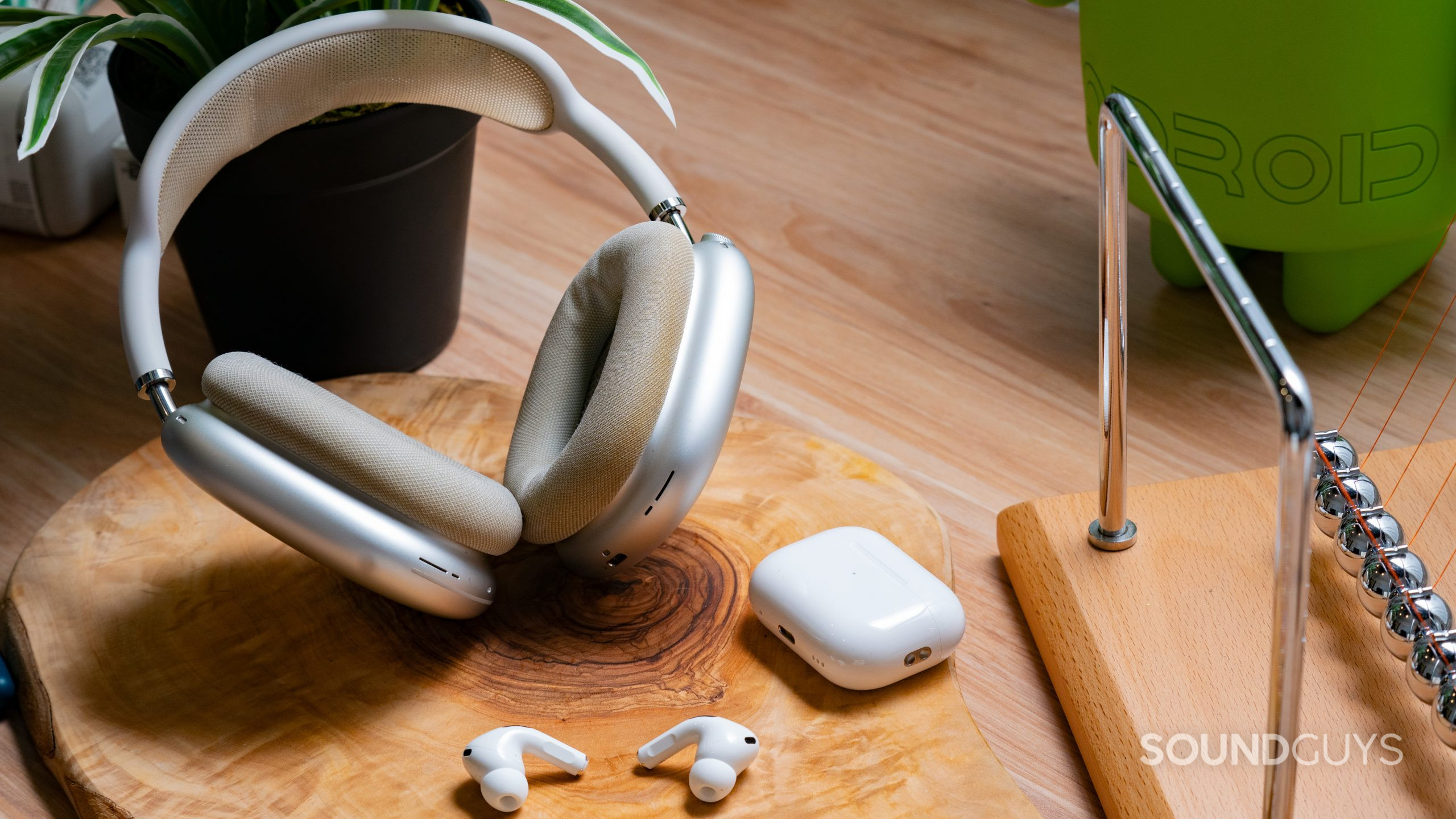
On the other hand, the Apple AirPods Max is a pair of over-ear headphones, much different from the AirPods Pro. A mesh canopy headband evenly distributes the headset’s 386g weight along your head. The metal headphones feature a rounded rectangular shape, similar to the AirPods Pro charging case. Unlike Apple’s in-ears, the headphones come in four colors: silver, Space Gray, Sky Blue, pink, and green.
You get a Smart Case that doesn’t really protect the headset. Instead, the Smart Case forces the AirPods Max into low-power mode. Without the Smart Case, it takes 72 hours of inactivity before the AirPods Max enters low-power mode. The AirPods Max is not IP-rated, so it’s not safe to take out into the rain or spill any liquids on.
Apple AirPods Max vs AirPods Pro 2: Controls
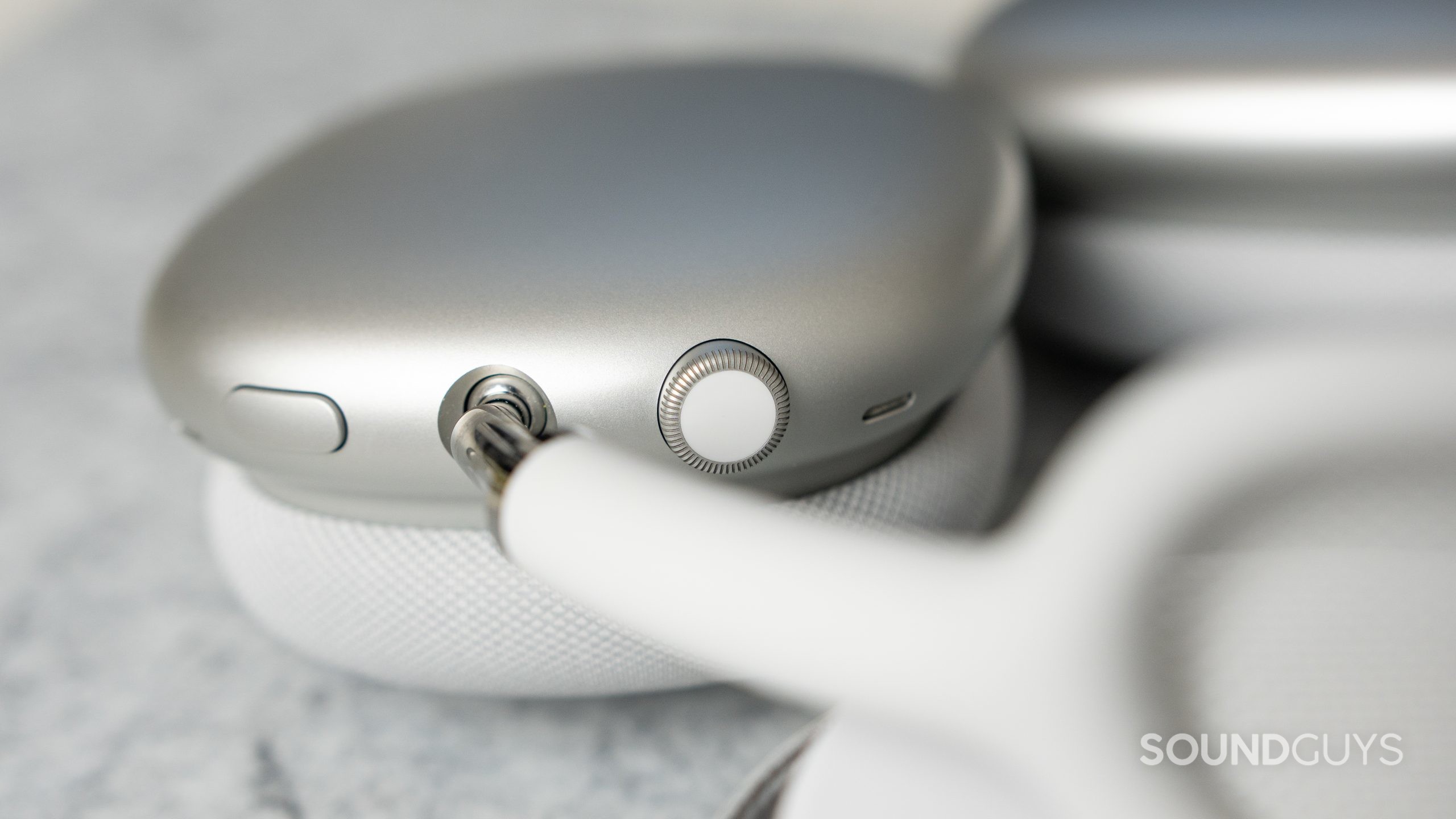
Controlling the Apple AirPods Pro (2nd generation) involves squeezing and swiping gestures on the earbud’s stem. You can also remap some of the controls in the Settings app of an iOS/iPadOS device.
Apple AirPods Pro (2nd gen) controls:
| INPUT (stems) | ACTION |
|---|---|
One press | Play/pause/answer call |
Two presses | Next track |
Three presses | Previous track |
Press and hold | Toggle ANC/Adaptive Transparency modes |
Swipe up/down | Increase/decrease volume |
"Hey Siri" | Change volume, request directions, playback control, receive messages, and more |
To control the Apple AirPods Max, there is a digital crown button on the top of the right ear cup for controlling volume and playback, as well as a noise canceling button to toggle between ANC and transparency modes. The AirPods Max doesn’t support touch controls.
Apple AirPods Max controls:
| Action | Media controls | Call controls |
|---|---|---|
| Action Noise control button | Media controls Toggle ANC and Transparency mode | Call controls ✘ |
| Action Headset: remove/wear | Media controls Auto-pause/play | Call controls ✘ |
| Action Digital Crown: rotate | Media controls Adjust volume | Call controls ✘ |
| Action Digital Crown: one press | Media controls Play/pause | Call controls Answer/end call; answer incoming call and put current call on hold |
| Action Digital Crown: two presses | Media controls Skip track | Call controls Reject incoming call; answer incoming call and end current call |
| Action Digital Crown: three presses | Media controls Previous track | Call controls ✘ |
| Action Digital Crown: hold | Media controls ✘ | Call controls Reject second incoming call |
| Action Customizable controls? | Media controls Yes, ANC toggle only | Call controls No |
Apple AirPods Max vs AirPods Pro 2: Software
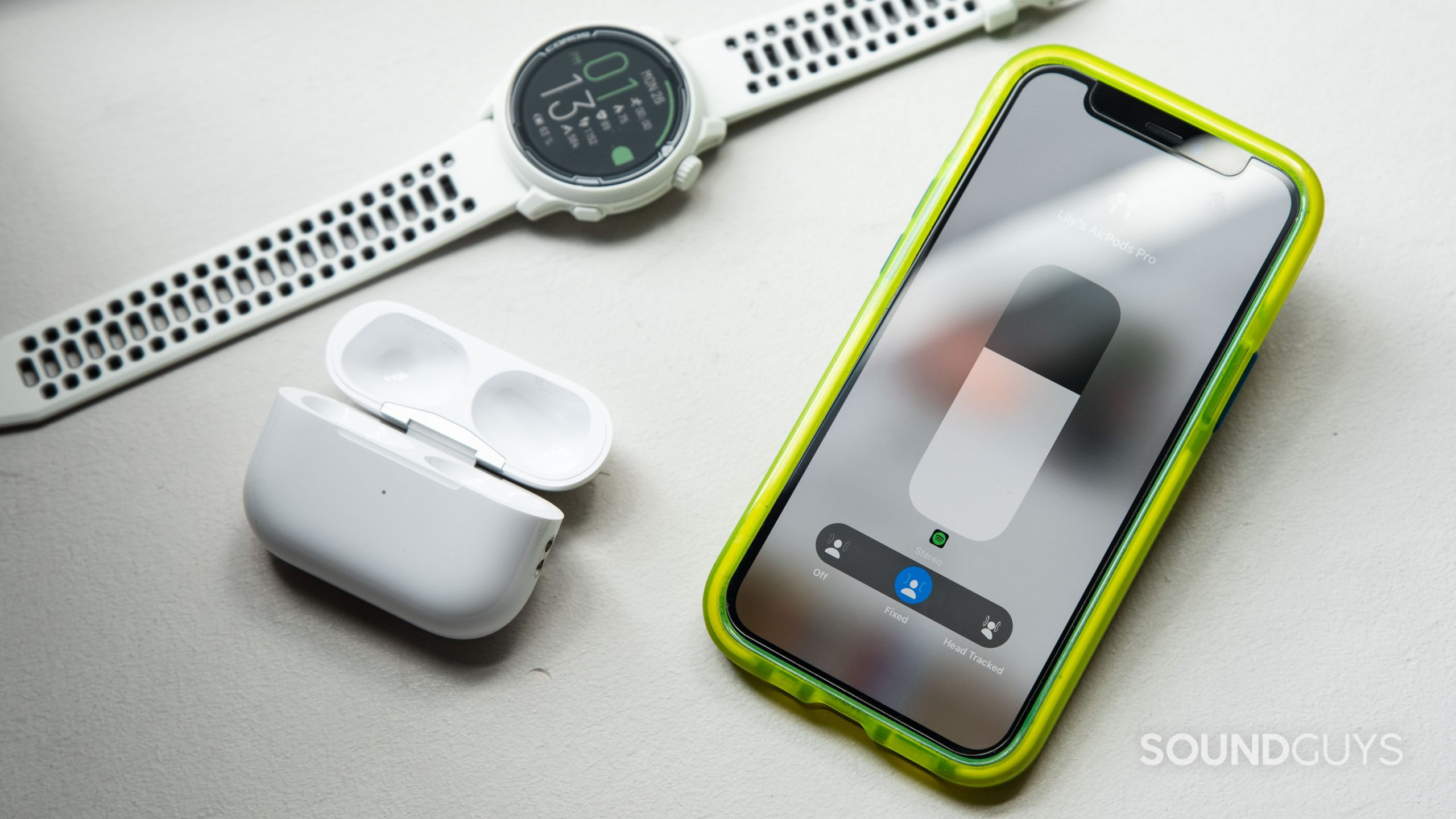
The software options for the Apple AirPods Pro (2nd generation) and the Apple AirPods Max are very similar. Both use the iOS or iPadOS Settings app to access software options and customization, which is inaccessible to Android users.
In the Settings app, features like personalized Spatial Audio, customization of some of the controls, firmware updates, noise controls, and Find My AirPods are available for both the AirPods Pro (2nd generation) and the Apple AirPods Max.
The biggest differences between the two is that the AirPods Pro (2nd generation) has a more updated Find My AirPods setup since the case now has a speaker that makes a sound to help you locate it, and the ultra-wideband U1 chip allows for precision tracking. This does require you to share your location, which isn’t ideal for the privacy-inclined. While both sets of AirPods feature Transparency mode that transmits external noise through the headset, the AirPods Pro (2nd generation) takes it one step further with Adaptive Transparency powered by the H2 chip. When you enable this feature on the second-generation AirPods Pro, unpredictable, loud noises don’t come through as loud and piercing as they might through the AirPods Max or older AirPods models.
Apple AirPods Max vs AirPods Pro 2: Connectivity
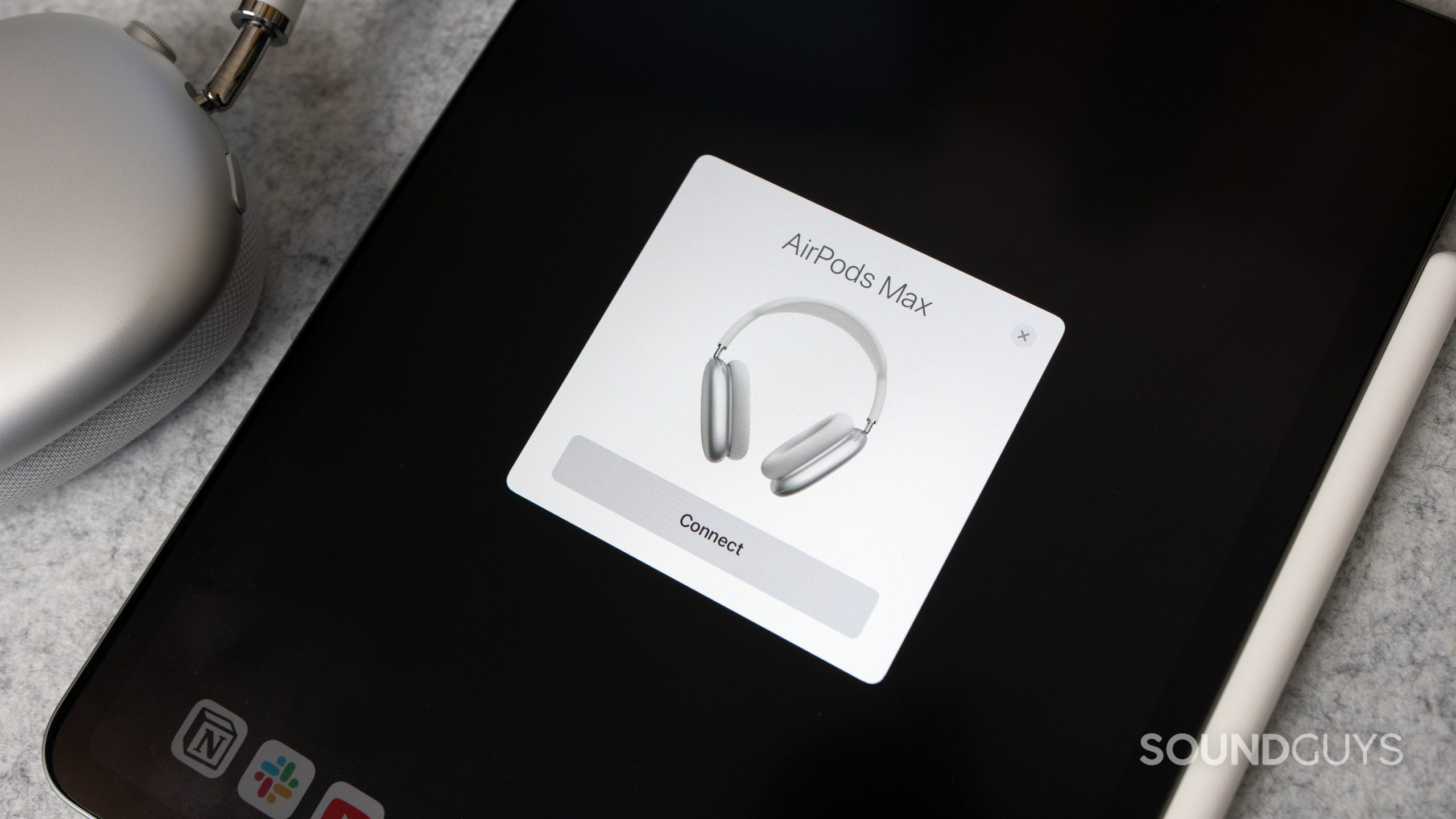
With the Apple AirPods Pro’s H2 chip and the AirPods Max’s H1 chip, both connect easily to Apple devices. Taking either out of its case and putting it near an Apple device will trigger a screen prompt on your device to connect. The chip integration with Apple devices makes it easy to quickly connect and switch between devices logged into the same iCloud account.
The AirPods Pro (2nd generation) uses Bluetooth 5.3, while the AirPods Max uses Bluetooth 5.0. Both only support the AAC and SBC Bluetooth codecs, which is great for Apple users, but that means there’s no reliable, high-quality Bluetooth audio option for Android users (unsurprisingly). Notably, the AirPods Pro(2nd Gen) now sport a new USB-C case, replacing the Lightning port, making them more in line with the iPhone 15 series and inadvertently taking a step towards better compatibility with Android flagships. You could use the AirPods with Android phones before, but now you can charge everything with the same USB-C cable.
In addition, the newly-refreshed AirPods Pro (2nd generation) with USB-C charging case is currently the only Apple product to support lossless audio streaming with the upcoming Apple Vision Pro. This is thanks to a new H2 chip found on the refreshed earbuds, which now supports a 5GHz wireless frequency that enables lossless audio transmission.
The AirPods Max have not yet been updated to USB-C and continue to use the Lightning port. We expect them to switch over sometime next year, though Apple also has not announced an AirPods 4 yet. You can listen to the AirPods Max over a wired connection using a Lightning cable with an adapter to plug it into a 3.5mm port.
Pairing the AirPods Pro or AirPods Max to a non-Apple device is pretty simple, comparable to pairing any other Bluetooth device.
To pair the AirPods Pro to a non-Apple device,
- Make sure Bluetooth is turned on on your device.
- Open the AirPods Pro case and hold the setup button on the back for 5 seconds until the white LED flashes.
- In your device’s Bluetooth menu, choose the AirPods Pro in the devices list.
To pair the AirPods Max to a non-Apple device,
- Ensure Bluetooth is enabled on your device.
- Hold the noise control button on the AirPods Max for 5 seconds until the light flashes
- In your device’s Bluetooth menu, choose the AirPods Max in the devices list.
Apple AirPods Max vs AirPods Pro 2: Battery Life
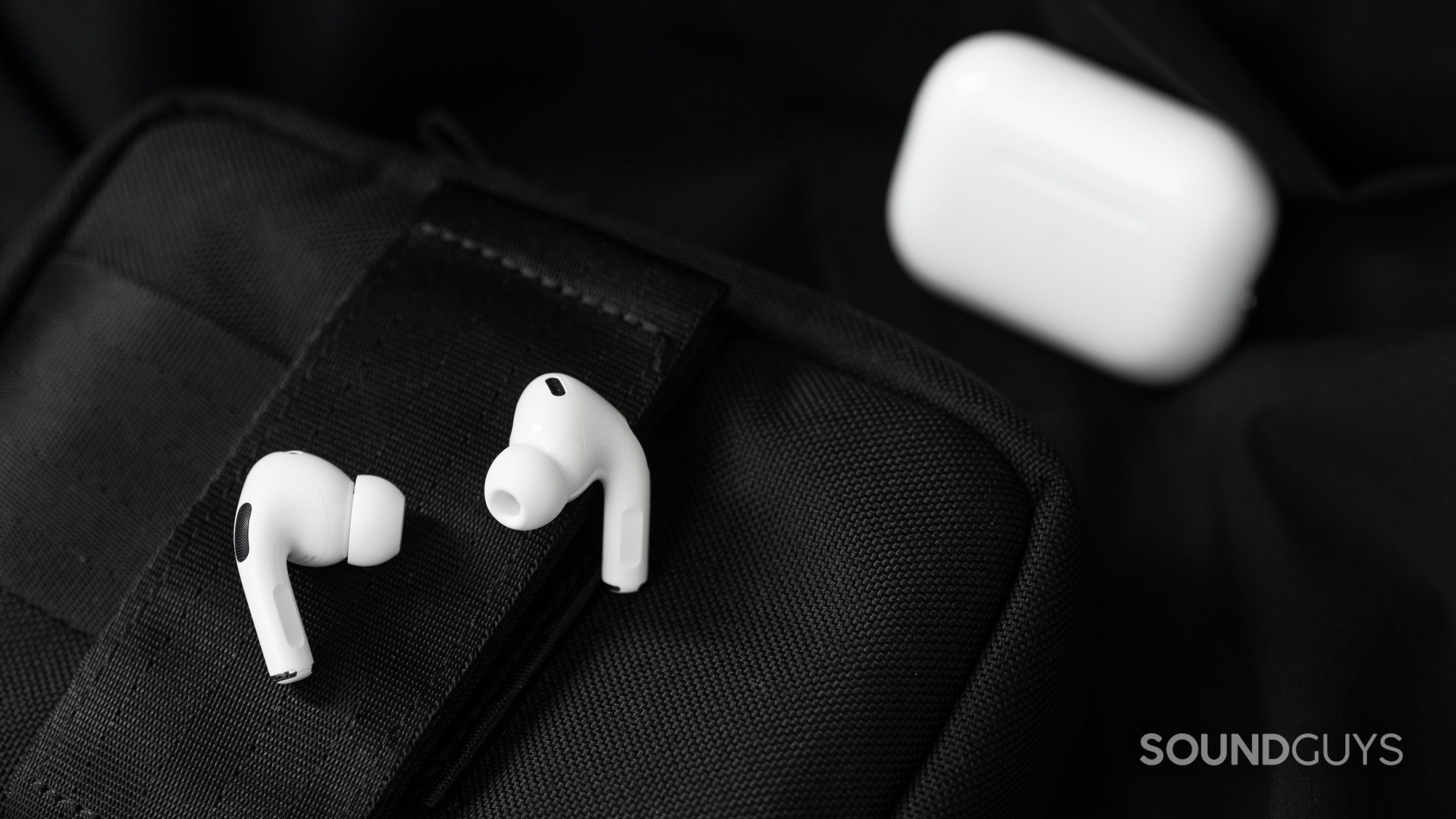
In our battery testing, of constant music playback peaking at 75dB(SPL), the Apple AirPods Pro (2nd generation) lasted 5 hours 43 minutes with ANC on, which is just a bit short of Apple’s advertised 6-hour battery life. The charging case adds an additional 24 hours of listening time to the earbuds, or 19 hours and 30 minutes of talk time.
The Apple AirPods Max lasts much longer at almost 21 hours with ANC on. As mentioned earlier, the AirPods Max doesn’t have an off button, so it constantly drains the battery when it’s not in use. It goes into low power mode if you put it in its case, but even then, it’s still draining the battery a little.
The battery-draining issue of the AirPods Max and the small battery life of the AirPods Pro doesn’t make for the most environmentally friendly options. The more charge cycles a battery goes through, the shorter its life becomes. If you want to avoid creating battery e-waste with your headphones, you should opt for headphones with longer battery life or wired ones. The most environmentally conscious people may not want either of these options.
Apple AirPods Max vs AirPods Pro 2: Noise cancelation
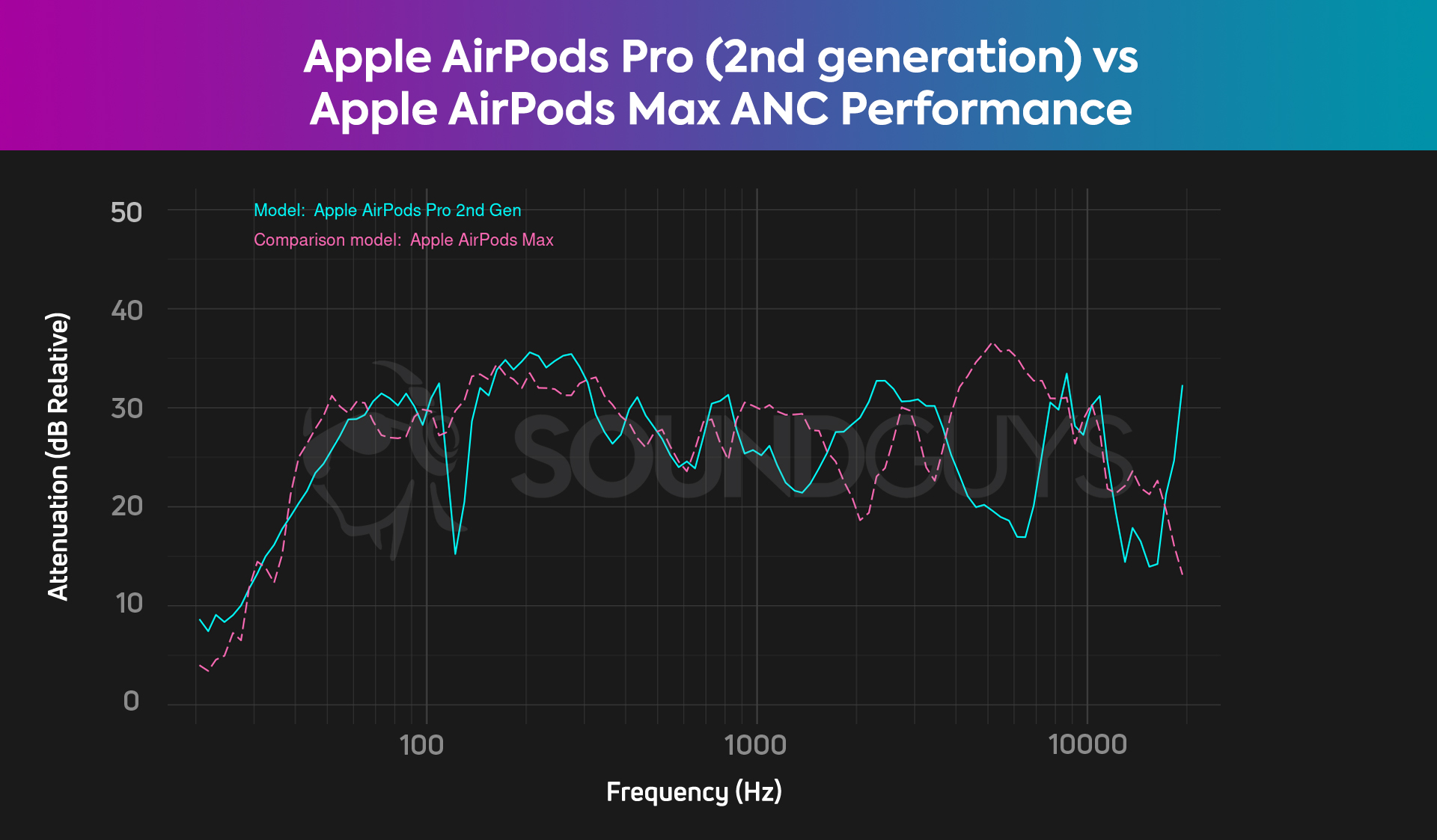
The Apple AirPods Pro (2nd generation) and the Apple AirPods Max both have excellent noise canceling, but the AirPods Max is just marginally better. For reference, our score for the AirPods Pro (2nd generation) is 8.2/10, and for the AirPods Max, it’s 8.3/10. The AirPods Pro just has two little dips, one between 100-200Hz and one between 3-8kHz, where it just doesn’t quite match the AirPods Max. Nevertheless, both are amazing at canceling out noise.
Both also have good isolation, with the AirPods Max having just slightly better isolation in the low end and the AirPods Pro having better isolation in really high frequencies. A proper fit is integral for good isolation and good noise canceling since having outside noise leaking in will diminish the performance of both. This can lead you to turn up your volume to dangerous levels, putting you at risk of noise-induced hearing loss.
Apple AirPods Max vs AirPods Pro 2: Sound Quality
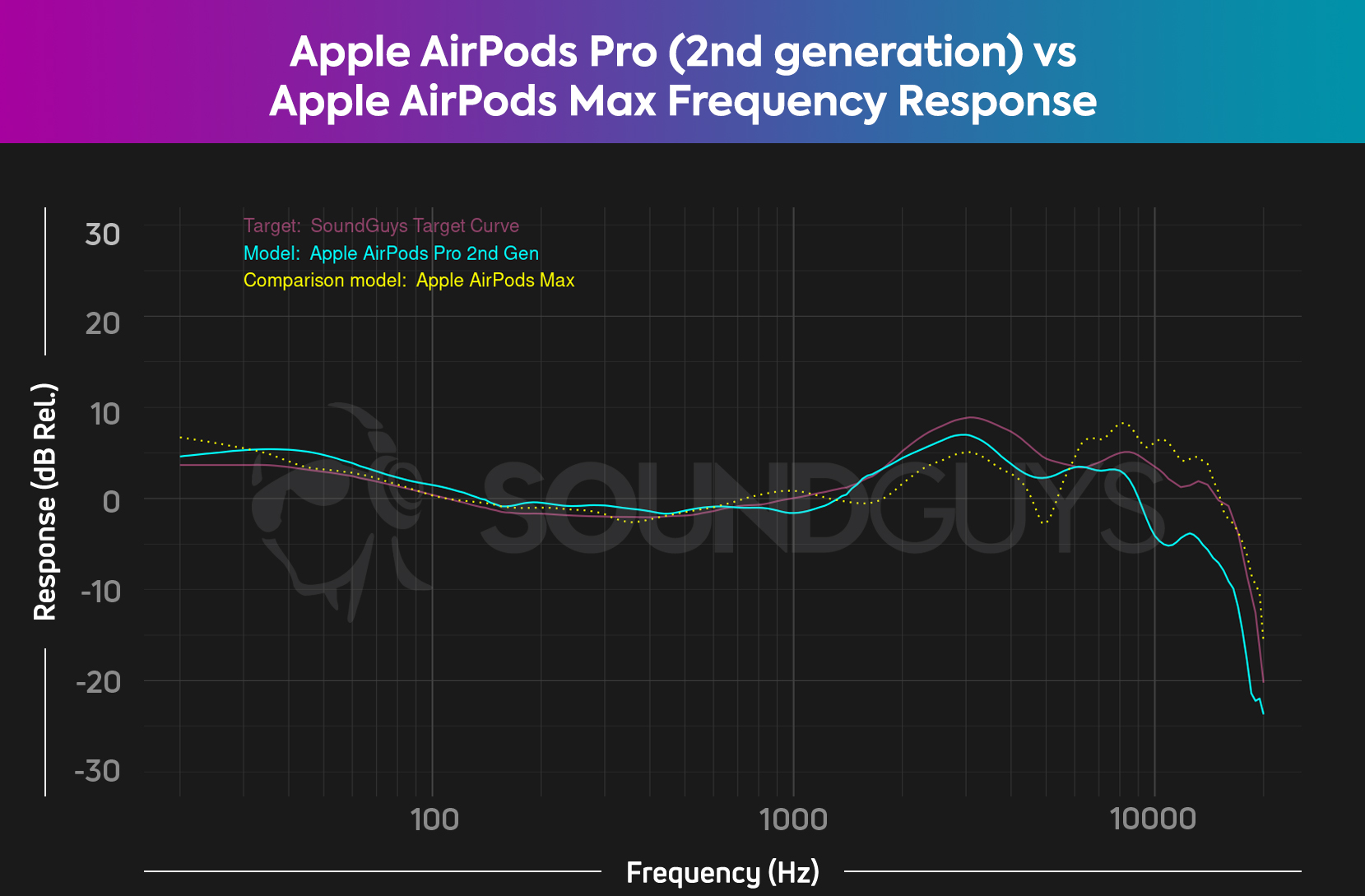
The AirPods Max and the AirPods Pro (2nd generation) have largely similar sound profiles in the lows and midrange, both of which measure close to our target curve in our testing. The AirPods Pro puts out less level in the highs relative to our target. The AirPods Max is a touch under-emphasized in the upper mids and uses a different tuning, leading to comparatively more output at the high end. Either will sound quite good to most people, which is fortunate because you can’t change the EQ without the help of a third-party app.
If you want to change the sound profile of either of these headsets outside of Apple Music, you won’t be able to do so using the default software. As of now, there are no EQ presets or custom EQ options in the Settings app.
Apple AirPods Max vs AirPods Pro 2: Microphone
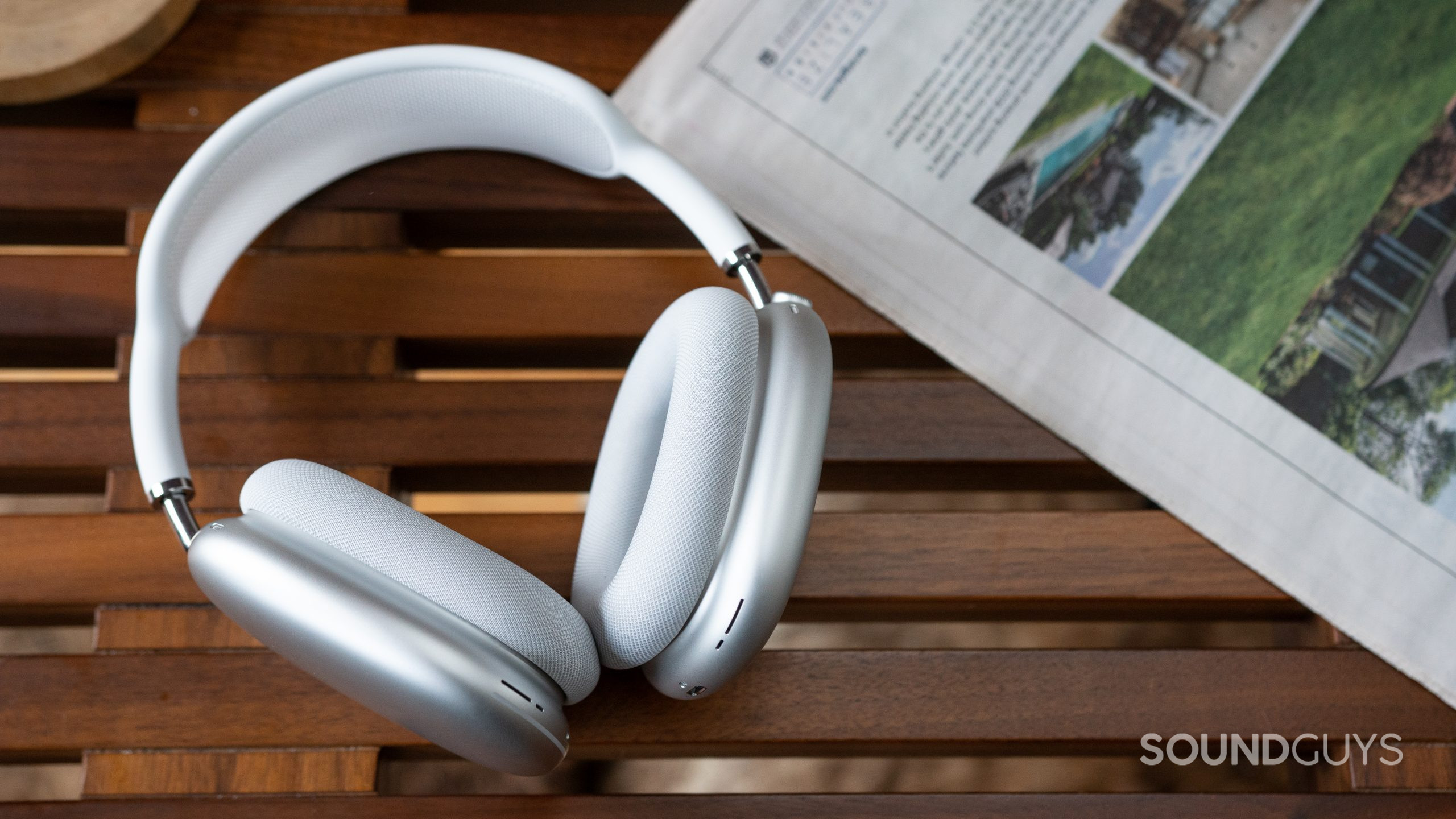
The Apple AirPods Pro (2nd generation) has a decent microphone, with a reduction in bass frequencies to help with voice intelligibility. It’s perfectly fine for phone calls, though background noise can cause voices to drop out. If you need to take calls on the AirPods Pro, try to do so in quiet, indoor places. There are also Mute and Unmute controls on the earbuds themselves.
The microphone in the Apple AirPods Max is really good when used with the right (Apple) devices. Otherwise, the AirPods Max doesn’t always do a great job of relaying voices. Your mileage may vary. Background noise isn’t suppressed particularly well, and it can also cause voices to drop out.
Apple added some software features to iOS 17 to pad up the feature list. There is a new Adaptive Audio listening mode, which dynamically blends Transparency mode and ANC. A new “Conversation Awareness” lowers the volume of the content being played when the user begins speaking to someone nearby. It also enhances the voice in front and reduces background noise. There is also a Personalized Volume feature that uses machine learning to understand environmental conditions and volume selections over time.
Apple AirPods Pro (2nd generation) microphone demo (Ideal conditions):
Apple AirPods Max microphone demo (Ideal conditions):
Apple AirPods Pro (2nd generation) microphone demo (Office conditions):
Apple AirPods Max microphone demo (Office conditions):
Which microphone sounds better?
Should you get the Apple AirPods Pro 2 or AirPods Max?
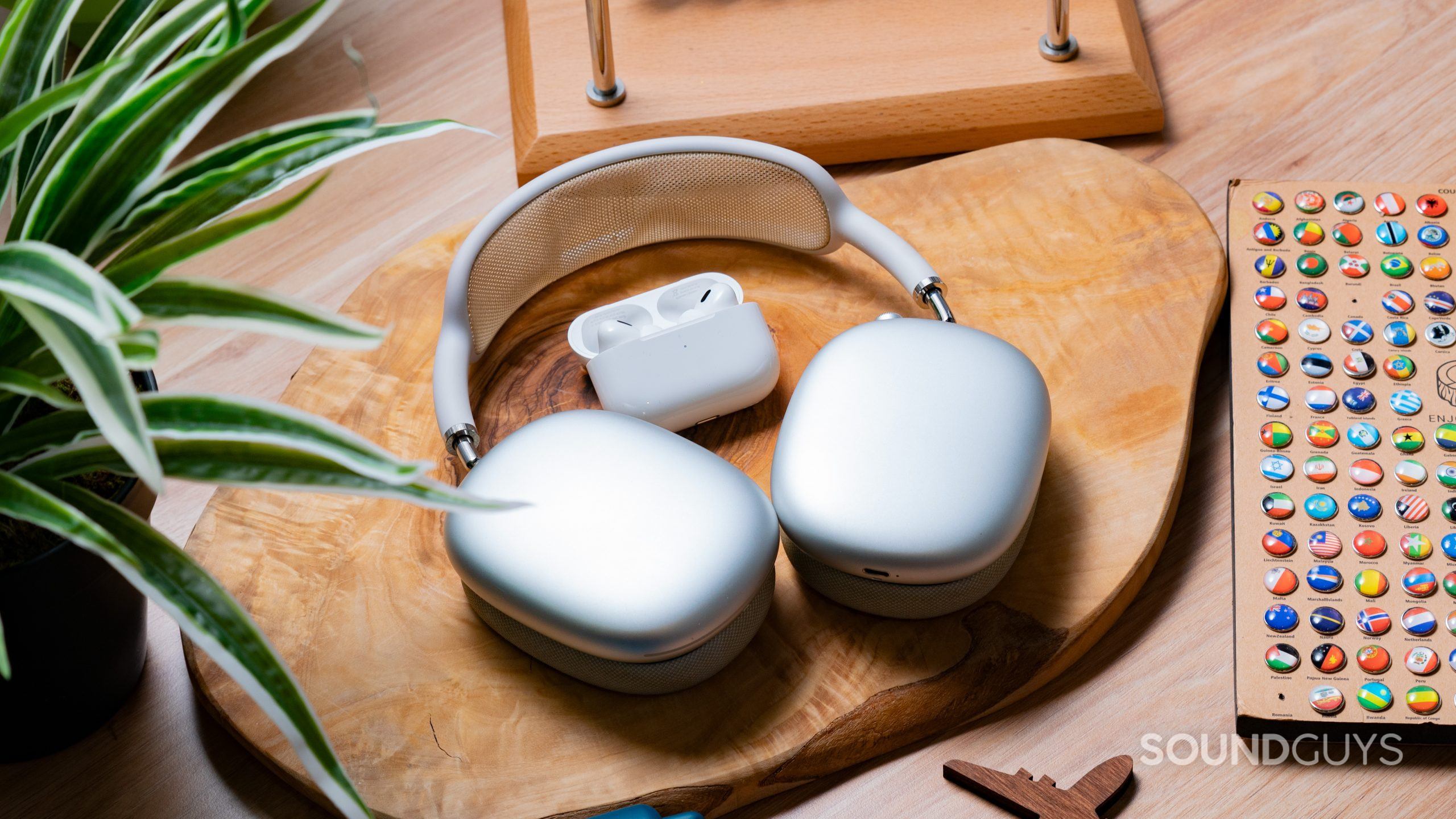
First things first, only consider either of these AirPods if you primarily use an Apple device. Android phone owners won’t have an ideal experience with either the AirPods Pro or the AirPods Max. If you are an iPhone user, the choice depends on your use case and preferences. The AirPods Pro (2nd generation) is more affordable, more compact, portable, and water resistant, and you can now charge them with industry-standard USB-C cables, which will probably appeal to most people. It has great sound and amazing ANC, making it one of the best pairs of wireless earbuds for iPhone owners.
iPhone users have the choice between the compact, portable AirPods Pro 2 for on-the-go listening and the comfortable AirPods Max for longer, at-home sessions.
However, those who prefer over-ear headphones and want a longer battery life might prefer the AirPods Max. This set of headphones is perfect for anyone already in the Apple ecosystem and who doesn’t like the feeling of in-ear and doesn’t plan on taking headphones into the rain. It’s good for people who work from home or work desk jobs since it’s easy to tune out the world, and the over-ear fit is more comfortable for longer periods of time. All these perks come at a cost, and the AirPods Max is more than double the price of the new AirPods Pro.

20-hour battery life
Well-built pads

Comfortable fit
Wireless charging
What should you get instead of the Apple AirPods Pro 2 and Apple AirPods Max?
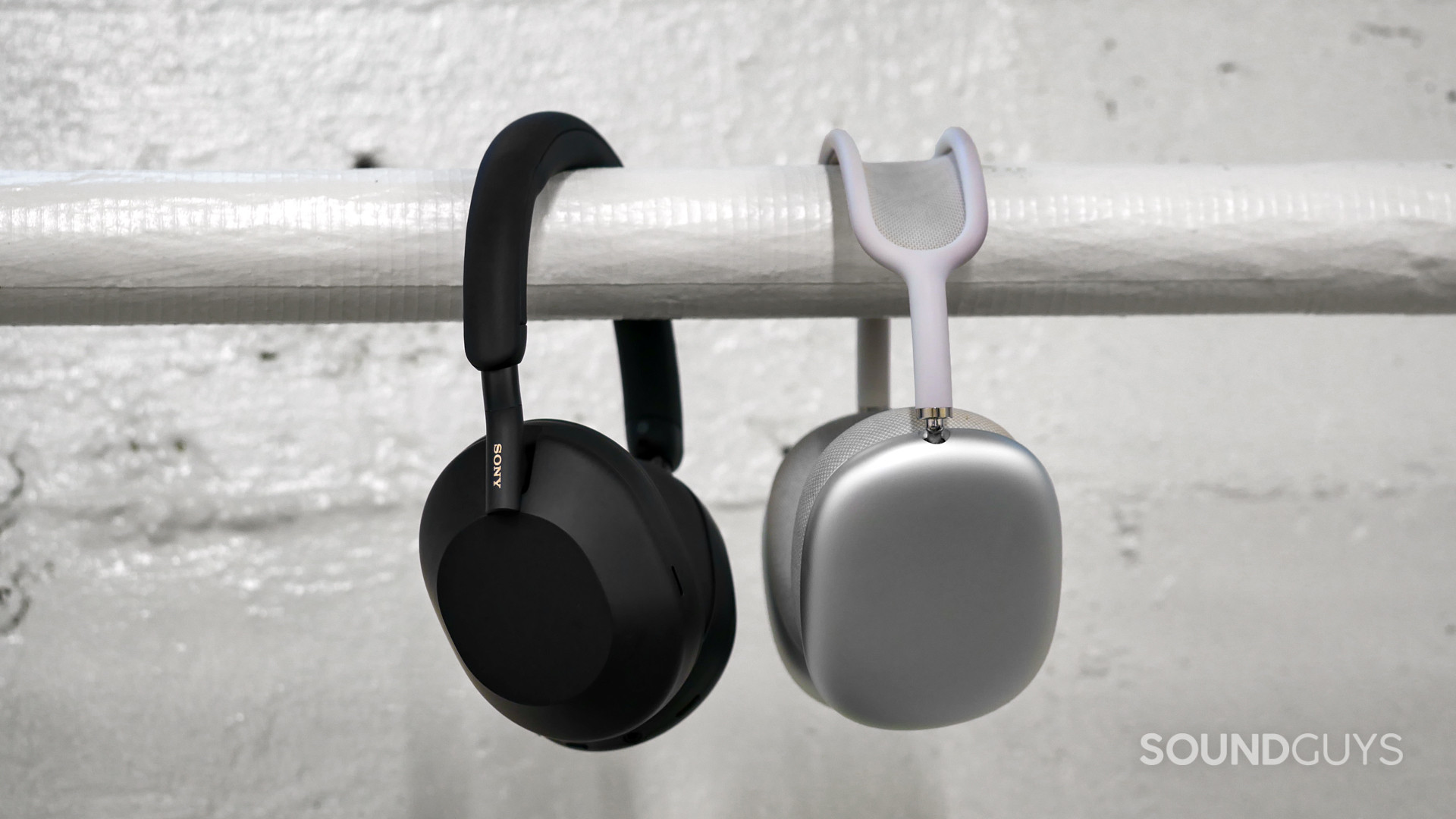
If you want to be able to use your headphones with any OS without issue, the Sony WH-1000XM5 compares well against the AirPods Max with its amazing ANC. Plus, the Sony WH-1000XM5 sounds good out of the box, and you can tinker with the Sony Headphones Connect’s in-app custom EQ module. With the WH-1000XM5, you get LDAC support for higher-quality Bluetooth audio on Android devices. It’s also way more affordable than the AirPods Max (though still expensive) at $399. The XM5’s predecessor, the Sony WH-1000XM4, is also a fantastic headset with a lot of the same features, just slightly lower performing ANC. It’s also more affordable at $278 at Amazon, so it’s another good alternative. See our list of the best AirPods Max alternatives for more headphones to choose from.
There are a lot of great AirPods Pro alternatives out there, but one really great alternative to mention is the Sony WH-1000XM5 earbuds. It’s OS-agnostic, using the Sony Headphones app, which is available on Android and iOS, and has best-in-class ANC. Like the above-mentioned Sony headphones, you can change the EQ in the app, and it also supports the LDAC codec. It’s a little pricier than the AirPods Pro at $299, but it’s well worth it for a great pair of noise canceling earbuds. You can read more about how they compare in our full article.
Frequently asked questions
The AirPods Pro 2 are unlikely to fall out while running due to the secure in-ear fit provided by the four sizes of silicone ear tips. However, fit can vary between individuals, so see our list of the best AirPods Pro ear tips for more options.
No, the AirPods Pro 2 are not waterproof. However, they are IPX4-rated, meaning they are sweat and water-resistant.
No, the AirPods Max is not IP-rated, which means they are not officially rated for protection against sweat or water. In other words, they will yellow over time.
No, you should not wear AirPods Max in the rain. The AirPods Max is not IP-rated, so it’s not safe to take them out into the pouring rain or spill any liquids on them.
No, without the Apple Settings app you won’t be able to install firmware updates. This means only people using Apple devices will be able to install firmware updates.
The AirPods Pro (2nd generation) only comes in the classic glossy white color, but the AirPods Max comes in silver, space gray, sky blue, pink, and green.
Though the prices fluctuate online, you can always check the manufacturer’s website for the suggested retail price. Our widgets already highlight if there’s a deal or not, however.
Yes, the AirPods Max is overpriced—it’s also a great pair of headphones. Apple tends to charge a premium for its products based on brand reputation and engineering costs.
Overall, the choice between these Apple headphones leans firmly in favor of the Apple AirPods Pro (2nd generation). It has an expanded feature set, including ANC for commuters, and improved hardware with the H2 chip managing Bluetooth 5.3 connectivity. Additionally, the ear tips make for greater noise isolation and sound quality. However, it’s important to consider the $80 price difference between the two.